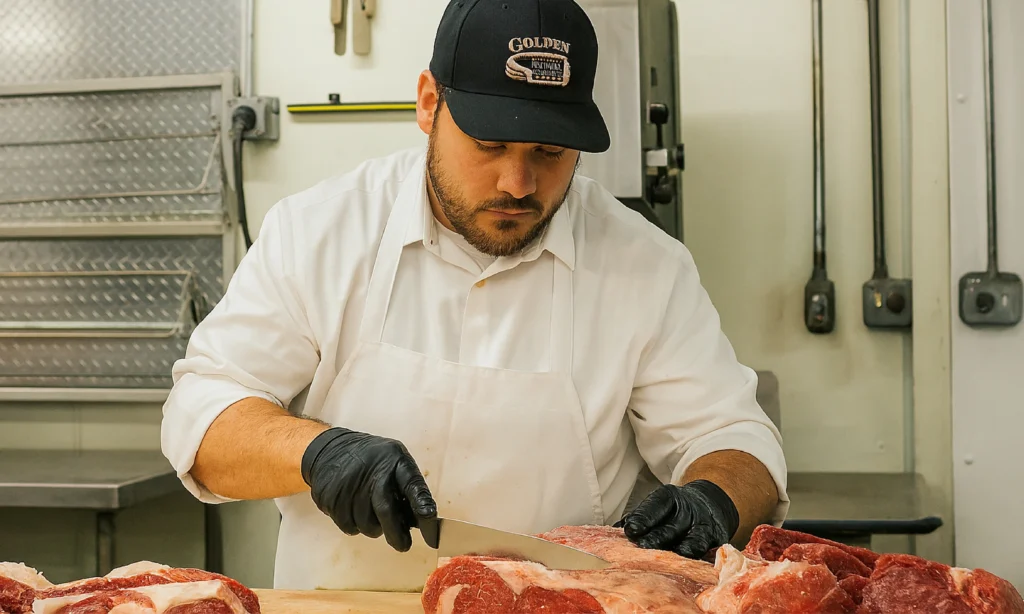The meat processing industry in Canada is one of the mainstays of the food manufacturing and the agriculture sector in the country, offering thousands of jobs both in rural and urban regions. In 2025, this industry still offers great prospects to workers who want to have a secure job with good salaries and prospects of career growth. The guide below gives a detailed description of the nature of work, working environment, wages and the future of the labourers in the meat processing industries of Canada.
Summary of Meat Processing Industry in Canada
The meat processing industry is the biggest sub-sector of food manufacturing in Canada with more than 1,600 businesses and an estimated 60,000 workers, and it plays an important role in the economy. It contributes 25 percent of food production income and brings billions of GDP and export. The industry also provides most of the workers with full time permanent jobs, most of them in the rural areas, thus also sustaining the local economies of provinces such as Ontario, Alberta, Quebec, and British Columbia.
The physically demanding tasks, poor working conditions, and the cold weather, and the rural location of most of the plants make the industry struggle with the recruitment and retention of laborers despite its size. All these coupled with the rising demand in meat products both due to domestic consumption and exportation make job opportunities to be in abundance particularly to laborers.
Common Laborer Jobs in Meat Plants
The meat processing plant laborers perform the much-needed practical work that helps in the production chain, such as:
- Helping in slaughtering, evisceration and cutting meat under supervision.
- Packing, sorting and trimming meat products to be shipped.
- Using simple machinery and packaging machines.
- Ensuring the clean and sanitary workstations as per food safety.
- Offloading and loading of shipments and preparing of products to be further processed.
Although some jobs, such as master butchers, are required to be certified and experienced, a variety of laborer jobs provide an opportunity to enter the industry with little to no requirements.
Skills and Requirements
The majority of the jobs in meat processing plants as laborers do not involve a formal education but rather expect:
- Physical endurance and strength as it is a repetitive job that requires standing on feet and lifting heavy objects.
- Capability to work in cold conditions, even below freezing point.
- Simple knowledge of English or French language, depending on the region.
- Desire to follow high standards of health and safety and hygiene.
- Ability to work shifts including nights, weekends as well as overtime when there is high demand.
Machine operation or safety training that is sometimes offered on the job by the employers allows laborers to expand their capabilities at the plant.
Salaries and Benefits
The meat processing plants in Canada offer competitive wages to the laborers that are in line with the challenging work environment. The entry-level salaries are usually between CAD 14.95 and CAD 20 per hour depending on the location and the employer. As an illustration, Conestoga Meats in Ontario provides laborers with a wage between CAD 20.70 and CAD 23.25 per hour and a shift premium. Skilled employees can receive increased rates or be selected to work in special positions with increased salaries.
The benefits that are offered by many employers include:
- Health, dental and vision care.
- Short-term disability and life insurance.
- Employer matching in the pension plans after one year.
- Employee assistance programs, wellness activities and scholarships.
- Consistent full-time schedules and the possibility to earn an overtime pay.
Such advantages can draw and retain employees in spite of the physical nature of the work.
Employment Problems and Prospects of the Industry
The meat processing industry in Canada is now facing serious labor shortages. In 2017 alone, 7,300 positions remained unfilled across the country and the hiring challenges keep growing, especially in such provinces as British Columbia, Quebec, and Ontario. The rural setting of most of the plants and the type of work puts many prospective employees off.
The industry however is central to the agri-food export aspirations of Canada, which has an export target of $75 billion by 2027, and expanding markets in Asia and the US. In order to satisfy the demand, meat processors are actively cooperating with government initiatives and search new approaches to recruitment and retention, such as better working conditions, promotion opportunities inside the company, and language classes offered to immigrants.
Opportunities of Career Advancement
The position of entry-level laborers is a good stepping stone. There are numerous employees who develop to skilled jobs like:
- Butchers, meat cutters or industrial.
- Packers and machine operators.
- Quality control and supervisory positions.
- Administrative or logistics jobs in the factories.
Employers such as Conestoga Meats focus on internal promotion, apprenticeship scheme and skills upgrading which enable the laborer to build a career in the industry over the long run and earn more and have more job security.
The Way to Locate Meat Processing Laborer Jobs in Canada
1. Job Boards and Internet Sites
The most common job boards in Canada, including Indeed, Workopolis, LinkedIn, and Job Bank, post meat processing laborer jobs in different provinces with new vacancies regularly.
2. Direct Company Applications
Larger employers such as Cargill, Conestoga Meats and other local processors advertise current vacancies on their careers websites. Direct application may facilitate the recruitment process.
3. Recruitment Agencies
Specialised staffing agencies specialising in food processing may be used in temporary and permanent placements and may be able to guide through documentation of foreign workers.
4. Community Resources and Networking
In some cases, local community centers and immigrant services help employers, particularly newcomers seeking entry-level jobs in processing plants.
Tips for Success in Meat Processing Jobs
- Insist on physical condition and trustworthiness during the applications and interviews.
- Be ready to work on flexible hours such as shift work.
- Take up any training or certification offered as soon as possible.
- Ensure that hygiene and safety standards are followed to the latter.
- Find a mentor or in-house development opportunities.
Conclusion
Meat processing plant jobs in Canada provide strong prospects to laborers in 2025. This industry is a good job opportunity with competitive salaries, benefits, and career growth opportunities even though it is physically and environmentally demanding. With the industry still growing and up-to-date, the need of specialized workers is stable, and motivated people can find the job in the provinces of the country.
With the inclusion of government assistance and employer programs, meat processing employees are ready to overcome labor shortages and become a vital part of the food manufacturing industry in Canada.



